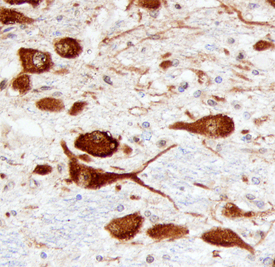Human/Mouse ATN1 Antibody Summary
Met1-Gln100
Accession # P54259
Applications
Please Note: Optimal dilutions should be determined by each laboratory for each application. General Protocols are available in the Technical Information section on our website.
Scientific Data
 View Larger
View Larger
Detection of Human and Mouse ATN1 by Western Blot. Western blot shows lysates of human liver tissue and mouse liver tissue. PVDF Membrane was probed with 1 µg/mL of Human/Mouse ATN1 Antigen Affinity-purified Polyclonal Antibody (Catalog # AF6567) followed by HRP-conjugated Anti-Sheep IgG Secondary Antibody (Catalog # HAF016). Specific bands were detected for ATN1 at approximately 150 kDa (as indicated). This experiment was conducted under reducing conditions and using Immunoblot Buffer Group 1.
 View Larger
View Larger
ATN1 in Human Brain. ATN1 was detected in immersion fixed paraffin-embedded sections of human brain (hypothalamus) using Sheep Anti-Human/Mouse ATN1 Antigen Affinity-purified Polyclonal Antibody (Catalog # AF6567) at 3 µg/mL overnight at 4 °C. Before incubation with the primary antibody, tissue was subjected to heat-induced epitope retrieval using Antigen Retrieval Reagent-Basic (Catalog # CTS013). Tissue was stained using the Anti-Sheep HRP-DAB Cell & Tissue Staining Kit (brown; Catalog # CTS019) and counterstained with hematoxylin (blue). Specific staining was localized to neuronal cytoplasm. View our protocol for Chromogenic IHC Staining of Paraffin-embedded Tissue Sections.
Reconstitution Calculator
Preparation and Storage
- 12 months from date of receipt, -20 to -70 °C as supplied.
- 1 month, 2 to 8 °C under sterile conditions after reconstitution.
- 6 months, -20 to -70 °C under sterile conditions after reconstitution.
Background: ATN1
ATN1 (Atrophin-1; also DRPLA protein) is a 190‑200 kDa member of the Atrophin family of proteins that is cleaved into 120‑150 kDa fragments. ATN1 is a ubiquitously expressed transcriptional coactivator. Human ATN1 is 1185 amino acids (aa) in length. It contains multiple motifs, including an NLS (aa 16-32), interspersed poly-Pro, poly-Ser and poly-His regions (aa 376-707), two RE (ArgGlu) repeats (aa 816-934), and an NES (aa 1033-1042). There are at least 17 utilized phosphorylation sites and one acetylated Lys. ATN1 is most characterized by a poly-Gln region between aa 484-497. Normally, there are about 20 consecutive Gln residues, but this number may be increased to more than 70 in pathologic conditions. Proteolytic cleavage generates large C-terminal fragments of 120-150 kDa size. These are unlikely to contain the NLS, and thus are typically cytosolic. ATN1 is suggested to form heterodimers with full-length ATN2/RERE, thus generating a transcriptional repressor. There are multiple potential isoforms. One shows an alternative start site at Met527, while others differ in the number of glutamines in the poly-Gln region. Over aa 1-100, human ATN1 shares 94% aa identity with mouse ATN1.
Product Datasheets
FAQs
No product specific FAQs exist for this product, however you may
View all Antibody FAQsReviews for Human/Mouse ATN1 Antibody
There are currently no reviews for this product. Be the first to review Human/Mouse ATN1 Antibody and earn rewards!
Have you used Human/Mouse ATN1 Antibody?
Submit a review and receive an Amazon gift card.
$25/€18/£15/$25CAN/¥75 Yuan/¥2500 Yen for a review with an image
$10/€7/£6/$10 CAD/¥70 Yuan/¥1110 Yen for a review without an image

